Adventures In Betting: $137.66 profit in four and a half days betting greyhounds on autopilot
Or $206.65 in seven days…but I’ve only compiled full stats for the four and a half days
I’ve been working on automated betting strategies for greyhound racing for a little while now, and when I’m working on it I tend to fiddle with the settings in response to how things do or don’t work, and also towards what I think might or should work. The more I fiddle with the settings, the harder it can be to determine how well (or not) it’s working as these things need to be given time to work through multiple days and see how they go with different tracks, qualities of fields, weather conditions, etc. Ideally an automated system should, once set up, be able to handle most variations in conditions with minimal drawdown and fairly consistent returns. It’s simply not possible to always win, so it’s also essential that an automated system has returns on good days which outweigh losses on bad days and ability to pull up the handbrake if things get too bad without blowing the bank, especially given an automated system will go unmonitored for periods of time and a lot can happen in a short space of time.
I’ve been pretty happy with the results of the greyhound systems I’ve been using for a bit of time now and decided it was a good time to put a moratorium on adjustments and just let them run and prove themselves. So late on Monday afternoon I did just that and let the systems run through until Saturday morning. The results impressed me more than I expected.
I had three strategies running on auto-pilot.
1. Lay the 4th favourite (that is, bet that it will not win) if it is paying odds of between $5 and $15, and is at least $2 more than the favourite, on Australia and UK races.
It made $67.22 profit
2. Lay the 3rd favourite (that is, bet that it will not win) if it is paying odds of between $5 and $9, and is at least $1.50 more than the favourite, on Australia and UK races.
It made $63.51 profit
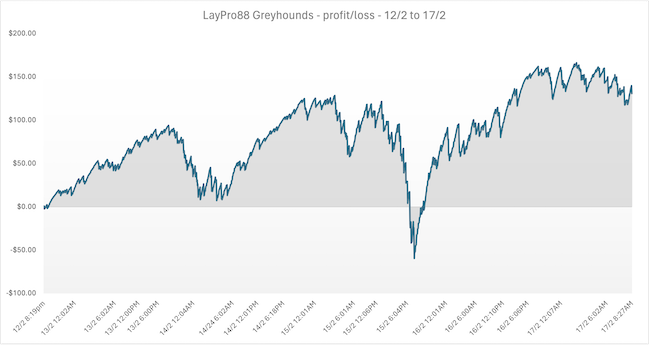
3. Back the favourite if it is paying odds of between $3 and $5, on Australia and New Zealand races.
It made $6.93 profit
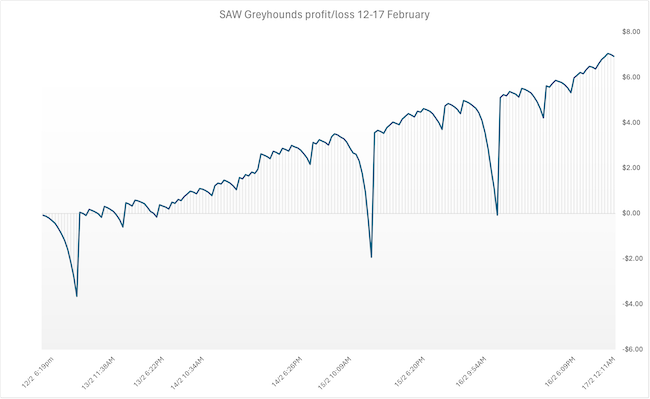
For the benefit of anyone unfamiliar with the concept of lay betting, this is a feature available on the Betfair exchange and is effectively the opposite of backing a horse/dog/whatever to win an event. Sounds simple, certainly easier than picking the winner, and it is, but at significantly reduced odds so it requires some careful staking strategies to make it worthwhile. If you’re familiar with the concept of betting on something to win, it’s easy to wrap your head around betting on something to not win.
Suppose you bet on a horse to win a race. You bet $1 and it is paying odds of $7.50. If the horse loses, you lose the $1 that you bet, but if the horse wins you receive your dollar back plus $6.50, meaning you’ve turned your $1 into $7.50. For the person on the other end of the bet, it is the opposite. If you’re betting with the TAB or a bookmaker, then the TAB or bookmaker is the party with the lay bet, but in the case of Betfair you are betting against other users of the exchange. So in the example we just went through, for the person with the lay bet, if the horse loses they win the $1 that was bet on it, however if the horse wins, they lose $6.50 which goes to the person with the successful back bet.
In my case for the lay bets I am using a staking method called LayPro88. The 88 here refers to the magical percentage of 88% strike rate which is where this method starts to turn a profit. So yes, in order for this method to work, the dog I am laying has to lose 88% of the time or more in order for me to turn a profit. I’ve seen it turn a profit at a lower strike rate, but 88% is a good guide number, and anything above that really starts to turn some fantastic profits.
The system is quite simple to follow. To start off, I lay the dog with a stake (the bet from the person backing the dog) of 50 cents (it doesn’t matter what the starting stake is, this is just the amount I have been using to go with the amount of bankroll which I attributed to each strategy, which was $100). If the dog wins, great, I got 50 cents profit, go again. But if the dog wins, then I have a loss and I add my original stake to the most recent stake, so my next stake will be $1. If that wins, then the next stake is reduced by 20% of the original stake. This process continues on an ongoing basis, but the stake can never go below the original stake.
So for example, a sequence of bets could look something like this:
1. 50c, win
2. 50c, win
3. 50c, loss
4. $1.00, win
5. $0.90, loss
6. $1.40, win
7. $1.30, win
8. $1.20, win
etc
For the back bets I am using a different system which requires a bit more calculation. It’s called “Stop At A Winner”. It works on the basis of trying to get a specific profit out of a race. In this example I was aiming for 12 cents per win. It is probably a bit on the conservative side and I could increase it a bit, but I am wary of the drawdown which can occur with this method (as could be seen multiple times in the graphs above) if there’s a bunch of races in a row where my selection does not win.
Effectively the way it works is this: In the first race the aim is for 12c of profit and so a bet is calculated based on the odds available to make that profit. Eg, if the dog is paying $3, the bet would be $0.06 (a 6c bet, if won, would get 18c back, 6c being the original bet and 12c being profit). If the bet wins, great, put that aside and start again. But if the bet loses, the 6c loss is added to the profit target so effectively in the next race we’re trying to make 12c profit plus recoup the previous loss. And this goes on with the stake size increasing until a winner is found. This tends to have a good steady growth, but the drawdown requires careful risk management and so reduces the bet size and profit a fair bit.
You could use these methods manually if you wanted, but in order for them to work particularly well it is important that the betting market is well-formed by plenty of bets having been placed so that the odds are a good reflection of what punters believe the chances of each runner are, so I have these bets being placed about 30 seconds before the scheduled start time of the race. This doesn’t leave a lot of time to place the bets manually, and while the LayPro88 method wouldn’t be too hard to do as you know exactly what stake size you need based on the result of the previous race, the Stop At A Winner method requires calculating and being able to get your bet on before the odds change (and the odds do move very quickly on a lot of races in the seconds before the race starts).
There is also the question of time. How much time do you want to spend on this? A tradeoff in my view is that an automated strategy should always have smaller bets than you would place manually to avoid something going wrong with the method and a terribly calamitous loss occurring without you seeing it, but at the same time an automated strategy can bet at all hours of the day and night so small bets can add up to quite sizable profit quite easily.
When you consider that Australian and New Zealand greyhound racing often starts around 11am eastern Australian time (earlier if NZ has a morning meeting and on Saturdays when Australian greyhounds start early to avoid racing in the afternoon during the premier thoroughbred horse racing) and run through until midnight or later, and UK dogs start mid-evening Australian time and run through until around 6-8am depending on the time of year, this is where an automated system can excel by betting 20+ hours of the day for you while you get on with life. In the examples in this post, the bots were doing the work while I was at work, or asleep, or doing grocery shopping, or playing with Pebbles and Shyley, or taking the motorbike out for a ride, or one of the million and one other tasks which crop up in life.
I’m using two automated tools for this. One for the LayPro88 method and one for the Stop At A Winner method.
For the LayPro88 method I am using the quite self-explanatorily named LayGreyBot by Steve and Michael from winningmore.com and profitsportsbetting.com

(click image to enlarge)
This is the main screen where you can see an awful lot of settings down the side which allows you to setup whatever strategy you want, and make it as selective or as open as you want. For example down the bottom you can go as far as selecting what types and grades of races you’re willing to bet on, you can choose which boxes you’ll accept the dog to start from, further up you can set things such as the minimum and maximum race distances you’ll accept, even how much other people have to have already bet on the race before you’ll consider it. For my method I have the settings pretty wide open so as long as there is some money in the market and the 4th (or 3rd) favourite meet my odds criteria, I’m pretty much happy to place the bet. I have a couple safeguard in place to ensure bet sizes can’t get too big and the market has some real liquidity to it, but that’s something I might dive into another time. It’s probably a bit too in-depth for this post. On the other side you can select or deselect individual races or entire meetings if you want, but I usually leave them all enabled.
The bot allows you to run up to three strategies simultaneously, so I have my fourth favourite strategy in “Lay 1” and my third favourite strategy in “Lay 2” (why not the other way around? Because I started with the fourth favourites first and added the third favourites later on after monitoring them for a while).
In addition, and this is where the bot really improves things over betting manually, it can run multiple races at once in the various tabs at the top of the screen. This is fantastic when you have multiple races occurring at about the same time, or a result from one race takes longer than usual because of a photo finish and the next race is due to start before the result of the previous race is known, or even just for delays in getting races started where you have placed a bet shortly before the advertised start time of a race, but it doesn’t get underway on time and you have other races to get to, something which happens quite often, especially with some of the UK meetings which can end up running an hour or more late sometimes.
Earlier on I mentioned that the stake size for this method depends on the result of the previous race, so each tab operates independently of the other tabs. Eg. a win or loss in tab 1 only affects the stake size of the next race in tab 1, likewise a win or loss in tab 2 only affects the stake size of the next race in tab 2, etc. The general recommendation from many people and even from Steve and Michael in their documentation for this and other similar bots is to only use a single tab for the LayPro88 method. This is good advice to avoid having multiple tabs hit a losing streak and all go down a fair way and need to recover through the process of getting more wins. But at the same time, knowing how many greyhound races there are and how a delay in one race can cause you to miss a whole heap more races, I actually run with all five tabs active.
Usually through the Australian races I only ever see activity in the first two tabs, but the British greyhounds tend to stretch out a bit more across the tabs due to the fact that British race results are slower to come through than Australian results, there’s a higher volume of races per hour in the UK most of the time, and often at least one race meeting is running behind schedule.
I wouldn’t recommend running multiple tabs until you’re comfortable with your strike rate percentage being around that 88% mark or better, but if you are using multiple tabs, my method for managing the recovery which some tab will inevitably need is that if one tab is comfortably in profit while another tab needs a greater volume of races through it to speed up recovery, I will temporarily disable the profitable tab to funnel more races to the tab which had been struggling. If the method is able to maintain the 88%+ strike rate over the long run, a bad day with a poor strike rate should be offset pretty soon by a day with a better strike rate, so it makes sense to feed a better day into the tab(s) which need it most.
For example, you saw the ups and downs of the overall results in the graph earlier, here are my results over the course of the days broken down by day and strategy. Note for this the first Australian day started about half way through the day’s racing, and I have treated the UK days as being entirely on the date on which they started in Australia, so for example the 12/Feb UK day ran from about 10pm 12/2 AEDT to 9am 13/2 AEDT but I have considered it all to be 12/2 for the sake of consistency in data reporting.
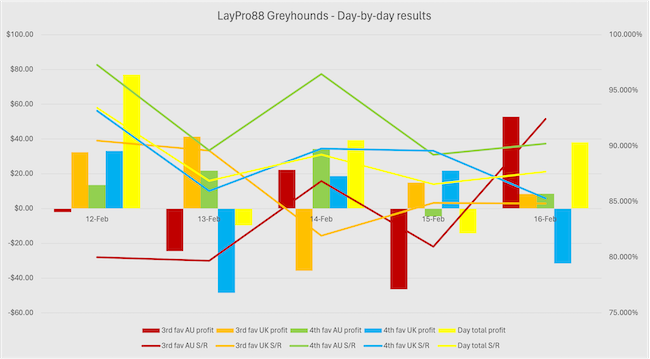
| 12-Feb | 13-Feb | 14-Feb | 15-Feb | 16-Feb | Total | |
|---|---|---|---|---|---|---|
| 3rd fav AU profit | -$2.00 | -$24.41 | $22.30 | -$46.42 | $52.77 | $2.24 |
| 3rd fav AU S/R | 80.000% | 79.688% | 86.842% | 80.952% | 92.424% | 84.735% |
| 3rd fav UK profit | $32.42 | $41.38 | -$35.79 | $14.89 | $8.37 | $61.27 |
| 3rd fav UK S/R | 90.476% | 89.583% | 81.928% | 84.884% | 84.821% | 86.515% |
| 4th fav AU profit | $13.55 | $21.81 | $34.20 | -$4.46 | $8.47 | $73.57 |
| 4th fav AU S/R | 97.297% | 89.610% | 96.471% | 89.216% | 90.217% | 91.858% |
| 4th fav UK profit | $33.06 | -$48.42 | $18.75 | $21.73 | -$31.47 | -$6.35 |
| 4th fav UK S/R | 93.162% | 85.950% | 89.764% | 89.565% | 85.294% | 88.636% |
| Day total profit | $77.03 | -$9.64 | $39.46 | -$14.26 | $38.14 | $130.73 |
| Day total S/R | 93.426% | 86.872% | 89.218% | 86.563% | 87.685% | 88.018% |
Monitoring this intermittently as it was going, I really thought the third favourites were struggling more than the stats demonstrate. They did have a lower strike rate than the fourth favourites, which is to be expected as a third favourite is by definition more likely to win than a fourth favourite, but managed to get some decent profits despite generally being below the magical 88% mark. I put this down to the fact that the upper odds limit I set on the third favourite strategy of $9 is the maximum amount for a loss to be fully recovered by the recovery cycle, and thus with most of the bets in this category having lower odds, any loss was well-and-truly recovered and then some by subsequent wins.
The fourth favourites did better in Australian than in the UK, probably due to smaller field sizes in the UK (they’re a maximum of six dogs per race whereas Australia runs up to eight per race) and the UK appears to have come in with a slight loss despite hitting 88%, but this is at least partially because the last couple of hours of the UK races had some losses which weren’t fully recovered at the point where I took the statistics.
It’s worth noting that the odds range on the fourth favourites extending out to $15 even though a loss on anything over $9 can’t be fully recovered in a recovery cycle (it would require more winners after returning to the original stake size) is done for a reason. Firstly, many fourth favourites have odds greater than $9 so you miss a lot of races if you limit the odds range, but more importantly it helps to keep the strike rate up. I did try reigning in the odds range to $5-$10 but it shaved about two percentage points off the strike rate and made the strategy only just break even overall. It stands to reason that the higher odds runners win less often and so the risk of bigger losses along the way is worthwhile when it also brings a better strike rate and better winning runs. At some stage I will analyse the strike rate of the fourth favourites in bands of the odds range and see if the odds range can be optimised a touch, but for now it’s working quite well.
The LayPro88 method has a lot of ups and downs and requires patience, but as long as the 88% or thereabouts can be maintained in the long run, it comes out quite nicely ahead. You can see that the overall figure was indeed just slightly over 88% strike rate.
There was a point in this where tab 1 was quite happily running ahead in profit while tab 2 had suffered a few losses, so I did disable tab 1 for a couple days so as to funnel the bulk of the races into tab 2. Apart from that, the system ran by itself with no intervention or input from me. In fact, four days and a half of racing, 1,811 bets placed in total, and I probably watched about 30 races in total.
One good thing about running the third and fourth favourite strategies simultaneously is that in many races, bot strategies will place a bet, and at least one of them has to win, usually both do. This helps to slightly reduce any losses accumulated in any given race.
An example from a UK race this morning at The Valley.
The system placed bets on two runners, one was third favourite and the other fourth favourite. The third favourites had been through a slightly rough patch so the stake size was up at $2.40 and the potential loss $13.44, while the fourth favourites were doing well so it was at the base stake size of 50c with a potential loss of $4.10.
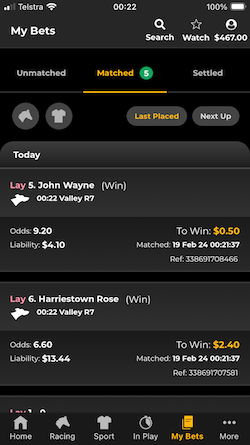
Due to the fact that at least one of these runners had to lose the race and be a successful lay bet, the potential losses on the race were not as high as the individual bets showed. If they both lost the race, it would be a profit of $2.90. If the third favourite won, it would be a loss of $12.94, not $13.44. If the fourth favourite won, it would be a loss of $1.70, not $4.10.
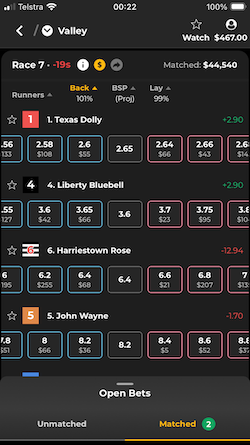
As it happened, the favourite won the race.

So both lay bets were winners.
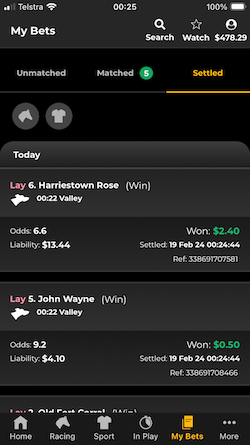
I’ll probably go into some more detail of the interface of the LayGreyBot at a later stage, but it’s very nice to have an overall results tab showing you all of the results from your bets as they happen.
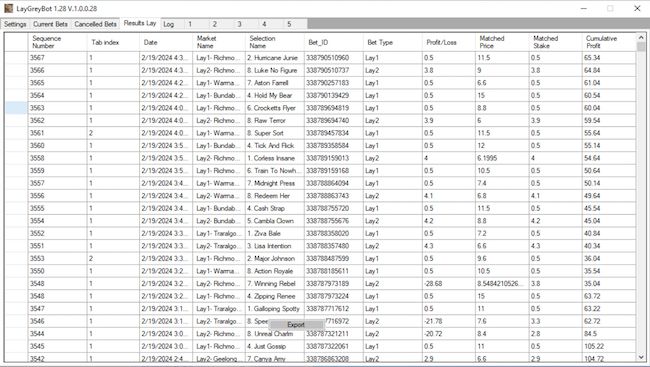
(click image to enlarge)
In addition to being able to go into each tab and see not only its results but exactly what it is doing at this moment and how its profit/loss stats look. In this picture, tab 1 has a bet in progress in Traralgon and some recovery to do on the third favourites while the fourth favourites are steaming ahead.
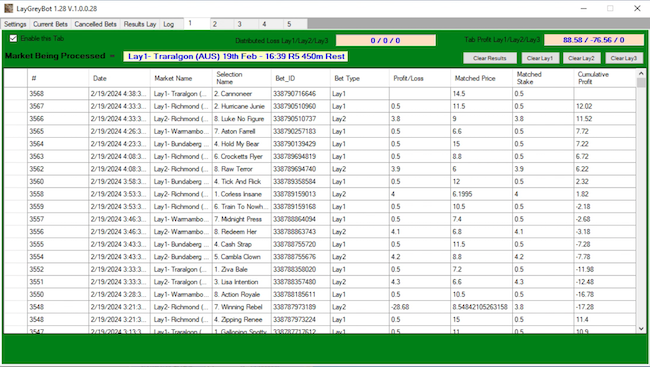
(click image to enlarge)
I’ve spent a lot of time here focusing on the LayPro88 strategy and the Lay Grey Bot but of course I also have the Stop At A Winner strategy working on the Australian and New Zealand greyhounds. This, as I mentioned, is backing the favourite in the race if it is at odds of between $3.00 and $5.00.
For this I am using another one of Steve and Michael’s creations, the Stop At A Winner Deluxe Greyhound bot.
Functionally it looks and works very similarly to the LayPro bot, but with different settings options as it is designed to work with the Stop At A Winner staking method.
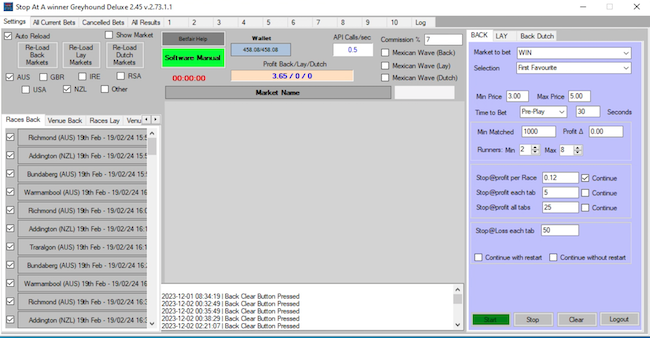
The results graph shows a bit of drawdown along the way, but the daily summary shows the consistency of the method.

| Day | Bets | Bets won | S/R | P/L | Running total |
|---|---|---|---|---|---|
| 12-Feb | 23 | 3 | 13.043% | $0.17 | $0.17 |
| 13-Feb | 29 | 8 | 27.586% | $0.93 | $1.10 |
| 14-Feb | 48 | 13 | 27.083% | $2.04 | $3.14 |
| 15-Feb | 44 | 10 | 22.727% | $0.96 | $4.10 |
| 16-Feb | 43 | 16 | 37.209% | $2.83 | $6.93 |
| Total | 187 | 50 | 26.738% |
When you consider that this bot had about a tenth of the number of bets as the LayPro system and a much lower strike rate around 26% compared to 88%, the fact it managed to make $6.93 or about a 20th of the LayPro system’s profit is actually quite a remarkable and respectable result.
I expect I will take a closer look at this bot in a future post, but for now suffice to say I am quite happy with the bot running the settings I have described and the quite consistent profit it manages to generate. Sure, it’s a smaller profit than the other method, but this is largely down to my risk-averse settings and I could turn it up a bit if I wanted to.
A question which probably arises from all of this is why am I working with Australia and the UK on the LayPro, and Australia and New Zealand on the Stop At A Winner. Why not all of the countries in both systems?
The statistics from a bit earlier on where the 4th favourite runners won races more frequently in the UK than in Australia helps to tell the story. I did originally try a few variations of the Stop At A Winner method on UK greyhound races but found it to be unreliable with lengthy runs of losses which increased staking beyond what I was comfortable with and hit my stop loss limits regularly. It was interesting in a way as it would have a run of really good days where the profit shot up, but then lose it all and more a couple times in a row in subsequent days.
This is one of the challenges with testing automated methods is getting a feel for when a system is producing results which are too good, and are probably a sign that a very poor period is ahead. In the case of the UK greyhounds, the narrower tracks tend to result in more bumping which makes it a tad harder for favourites to win, certainly enough of a difference to make the method not work well at all. From my testing, I believe it could be made to work if I was very selective about the tracks and distances which the system bets on, but I’m not convinced the small increase in profit it worth the time to work out which venues and distances would be a good fit. Perhaps that’s something you might be interested in pursuing.
As for the LayPro system not betting on New Zealand, well I would like to bet this method on New Zealand greyhound races and my perusal of race results indicates it should work very well, which is also backed up by the fact that the Stop At A Winner system does particularly well on favourites in New Zealand, but it seems that something in the way Betfair is describing the New Zealand races has changed and so the bot is having trouble working out if the races qualify or not. I have reported the issue and hope a fix will be delivered soon.
I started this post telling you how I made $137.66 on the greyhounds on autopilot in four and a half days, and that over seven days the total has reached $206.65, but I haven’t explained that yet. I have, however, shown you these figures throughout the post. You see, when I took the statistics on Saturday morning around 8am, I reset the bots, so they started from scratch with an entirely new set of statistics and staking. The screenshots above tell the story in the big boxes in the middle top of the main bot screens. The screenshots were taken this afternoon around 4pm, pretty much exactly seven days since I set the bots and left them largely to their own devices.
LayPro88 (third and fourth favourites combined) first period $130.73
Stop At A Winner first period $6.93
LayPro88 second period fourth favourites $120.57
LayPro88 second period third favourites $55.23 loss
Stop At A Winner second period $3.65
Total: $206.65
Later this week I intend to put together a live demonstration of how these methods and bots work, not as a live stream but in video form showing the bots in action as some races go by, which I think will help to explain the system a bit better and provide a better feel for how the bots work and how I work with them. It should certainly be better than me posting another dozen or so screenshots and writing another slab of text like this one.
Of course if you’re interested in following my footsteps or exploring the methods and bots for yourself, here are the links again to the homepages of the bots where you will find a lot more information about how they work and even a few videos.
Lay Grey Bot
Stop At A Winner Greyhounds Deluxe
I also have some strategies on the go for horse racing and soccer, but they will keep for another day. At the moment my main focus is on the greyhounds where I have been seeing some significant positive results after a decent amount of time and effort testing strategies, and I’m looking forward to showing you the strategies in action soon.
Samuel
Update 21/2/2024: Data analysis has led to a revision to the odds ranges to improve the strike rate. Details of this change can be found here.
February 19th, 2024 at 09:05pm